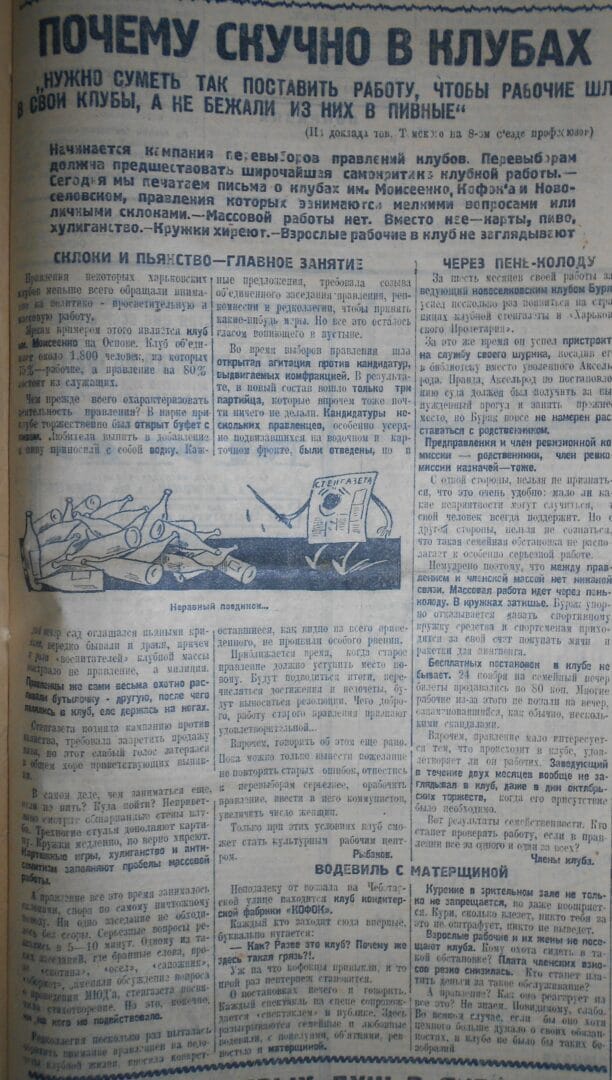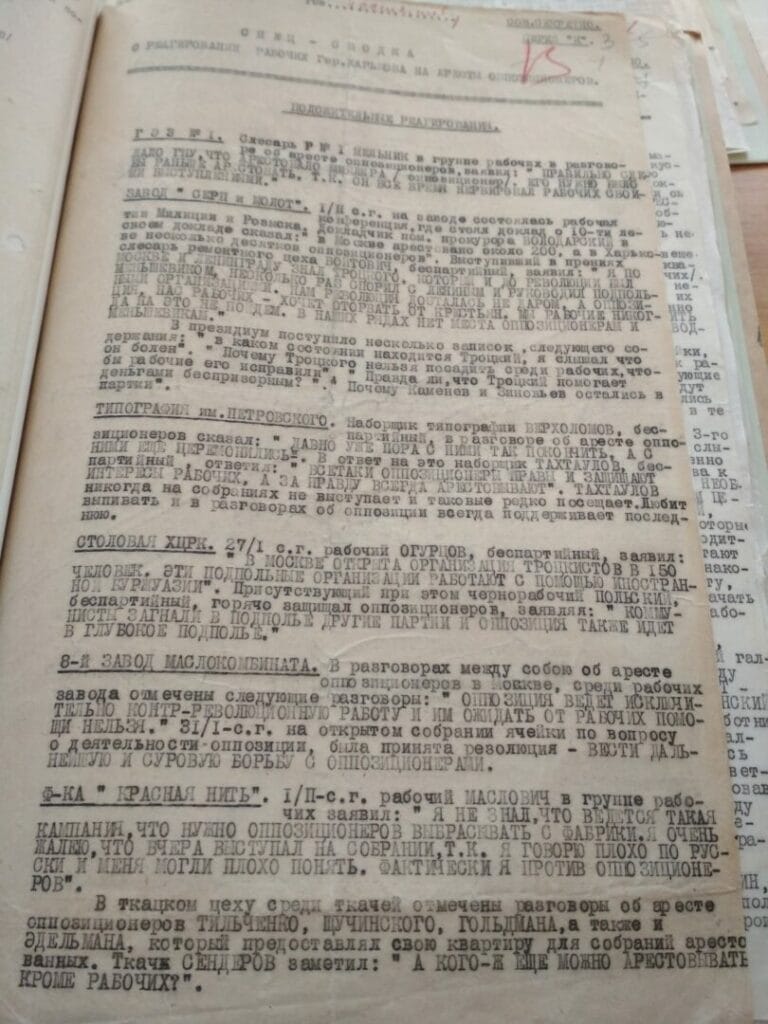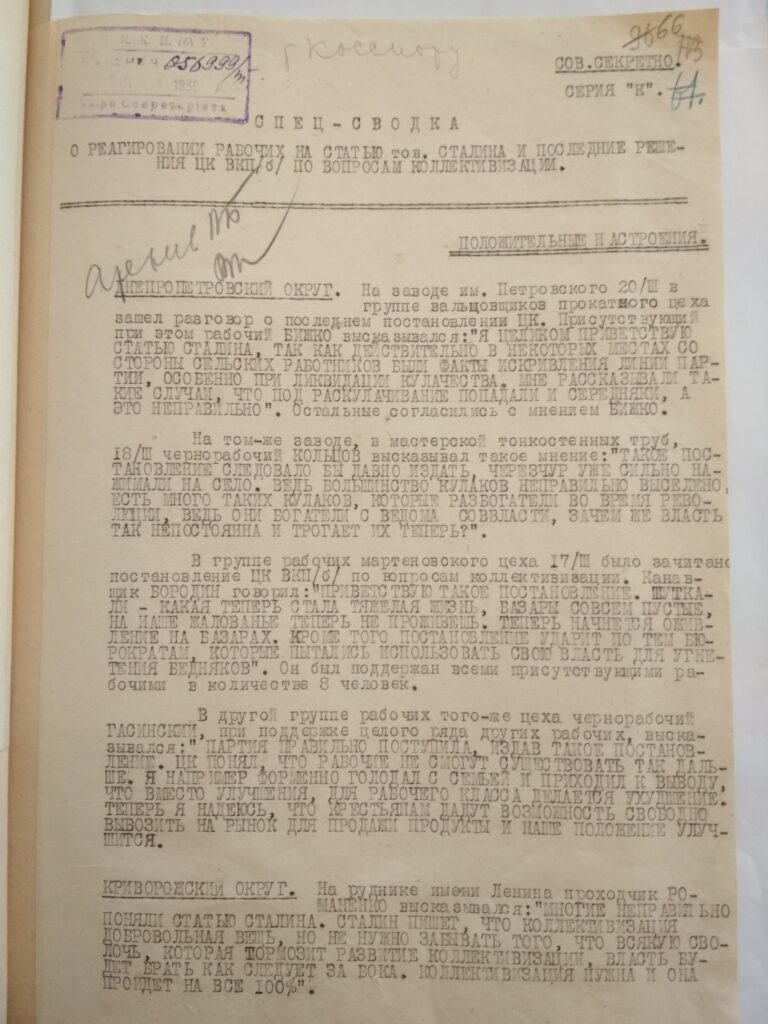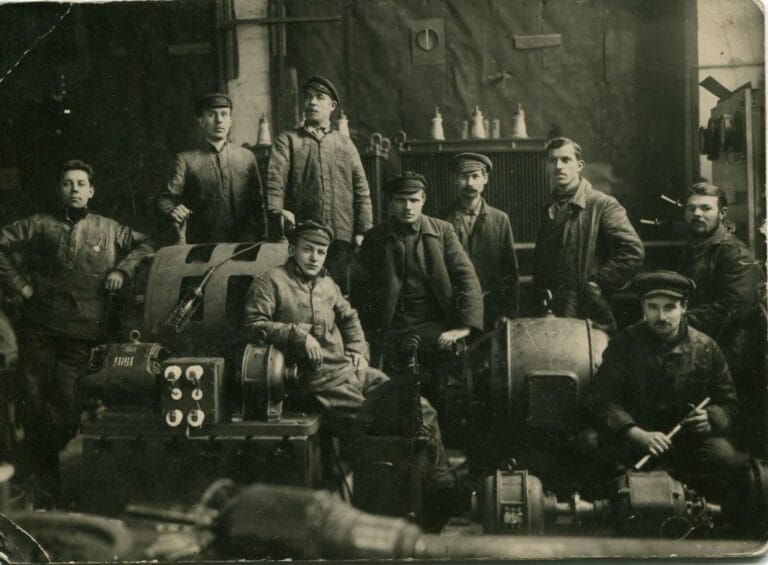WHY CLUBS ARE BORING
“WE NEED TO ORGANIZE WORK IN SUCH A WAY THAT WORKERS CHOOSE TO ATTEND THEIR CLUBS INSTEAD OF ESCAPING TO BEER HALLS.”
(From Comrade Tomsky’s report to the 8th Trade Union Congress)
The campaign for the re-election of club boards is commencing. Before the re-election, there should be extensive self-criticism of club operations. Today, we publish letters concerning the Moiseenko, Kofok’a, and Novoselovskyi clubs. These clubs’ boards are preoccupied with trivial matters or engaged in personal disputes. There is a lack of mass engagement. Instead, there are reports of card games, beer consumption, and unruly behavior. The overall condition of the clubs is deteriorating, and adult workers are not attending.
BICKERING AND DRINKING IS THE MAIN OCCUPATION
The boards of certain Kharkiv clubs paid minimal attention to political-educational and mass work.
A notable instance of this is the Moiseenko Club on Osnova.[1] The club has approximately 1800 members, with 75% being workers, yet the board comprises 80% employees.
What is the primary characteristic of the board’s activities? A beer buffet was introduced in the park near the club. In addition to beer, some individuals brought vodka. Every evening, the garden became filled with drunken shouts, often leading to fights. The enforcers disciplining the club attendees were not the board but the police. Board members themselves were often seen consuming a bottle or two, after which they would stumble into the club, barely able to stand upright.
The Wall newspaper launched a campaign against drunkenness, advocating for a ban on beer sales. However, this feeble voice was drowned out by the prevailing chorus of those who embraced alcohol.
Indeed, what other options are there but to drink? Where else can one go? The dilapidated walls of the club appear unwelcoming, complemented by three-legged chairs. The mugs are gradually disappearing. Gambling, hooliganism, and anti-Semitism are filling the void left by the absence of mass engagement.
And the board was preoccupied with bickering, arguing over the most trivial matters. Not a single meeting passed without a quarrel. Serious issues were resolved in 5-10 minutes. At one such meeting, where profanities like “cattle,” “donkey,” “shoemaker,” and “bum” replaced discussions on the organization of the International Youth Day, the wall newspaper dedicated a poem. However, this, of course, had no effect on anyone.
The editorial board made several attempts to bring the board’s attention to the shortcomings of club life, offering specific proposals and urging for a joint meeting of the board, the revolutionary commission, and the editorial board to address the issues. However, all these efforts fell on deaf ears.
During the election of the board, there was open campaigning against the candidates nominated by the comfraktion. Consequently, only three party members were included in the new composition, but they also contributed very little. Some candidacies, who were particularly active in promoting alcohol and card games, were withdrawn. However, as evident from the preceding information, those who remained did not demonstrate much enthusiasm either.
The time is nearing when the old board must yield to the new one. Results will be reviewed, accomplishments and deficiencies will be noted, and resolutions will be made. It’s conceivable that the old board’s performance may be deemed satisfactory…
However, it’s premature to speculate at this juncture. Presently, we can only express a hope to avoid repeating past mistakes, to approach the re-election process with greater seriousness, to diversify the board’s membership, including communists and increasing female representation.
Only under these conditions can the club truly evolve into a cultural hub for workers.
Rybakov.
IN A SLIPSHOD MANNER
During his six-month tenure, Buriak, the head of the Novoselkovskyi club, made multiple appearances in the club newspaper and in the Kharkovskyi Proletariy.
In the same period, he managed to hire his brother-in-law, placing him in the library position previously held by Axelrod, who was dismissed. Although Axelrod was entitled to return to his former position due to a court ruling on compulsory absenteeism, Buriak showed no intention of parting ways with his relative.
One person on the board of directors and a member of the auditing committee are relatives, and the treasurer, a member of the revolutionary comission, is also a relative.
On one hand, it’s undeniably convenient: you never know what kind of trouble might happen, and your friend will always come in help. However, it must be acknowledged that such a familial atmosphere is not conducive to serious work.
As a result, it’s unsurprising that there’s a disconnect between the board and the membership at large. Mass engagement is progressing in a slipshod manner, with activity fluctuating. Buriak is adamantly refused to gain funds to the sports club, and athletes must purchase balls and ping-pong rackets out of their own pockets.
There are no complimentary events at the club. On November 24th, tickets for a family evening were sold for 80 kopecks. Many workers opted not to attend the evening, which, as usual, was marred by several scandals.
However, the board shows little concern for the club’s activities and whether they meet the workers’ needs. For two months, the superintendent failed to visit the club at all, even on days when his presence, such as during the October celebrations, was necessary. These issues stem from nepotism. Who will oversee the work if the board operates under a “one for all and all for one” mentality?
Club members.
OBSCENE VAUDEVILLE
Not far from the railway station, on Chebotarskaya Street, lies the club of the confectionery factory “KOFOK.”
Anyone entering for the first time is often taken aback:
— Is this really a club? Why is it so dirty?!
Those from Kofok are accustomed to it, but at times, it becomes unbearable.
As for the performances, every show on stage is accompanied by a “performance” in the audience. Family and romantic vaudeville plays out here, featuring kisses, hugs, jealousy, and foul language.
Smoking in the auditorium is not only not forbidden, but even encouraged. Feel free to smoke as much as you like; nobody penalizes you for it, nobody escorts you out.
Adult workers and their spouses avoid visiting the club. Who would want to sit in such an environment? Membership fees have plummeted drastically. Who would be willing to pay for such a service?
And what about the board? How do they respond to all this? We don’t know. Apparently, not very effectively. In any case, if they had taken their responsibilities more seriously, the club wouldn’t be in such disarray.
Note:
[1] One of the districts in Kharkiv.






This newspaper article comprises reports by workers’ correspondents on the state of cultural and educational activities in Kharkiv clubs. The authors critique the process of electing club boards, offer recommendations on conducting them, highlight nepotism in position distribution, and denounce the use of alcohol and smoking in club premises. The Soviet government endeavored to transform workers’ clubs into model leisure facilities. Soviet leisure, as envisioned, encompassed active political engagement, self-education, and self-improvement for club attendees. However, visitors often favored traditional forms of recreation, and cultural workers frequently approached their duties perfunctorily. Clubs aimed to strike a balance between propaganda and entertainment, though maintaining it proved challenging. Hence, such reports were commonplace in periodicals.
It’s worth noting that this newspaper is the oldest periodical in the Kharkiv oblast, having been published almost continuously since 1917 under various names. The inaugural issue was released in May 1917 under the title Proletariy. Over subsequent years, the newspaper was issued under names like Kommunar and Proletariy as an organ of the Kharkiv Regional Committee of the Communist Party of Ukraine and the Regional Council of People’s Deputies. In 1924, it was renamed Kharkovskyi Proletariy (in Russian), and in 1930, Kharkivskyi Proletar (in Ukrainian). In 1934, the publication adopted the name Socialist Kharkivshchyna. Since 1990, it has been published under the name Slobidskyi Krai.
Soviet periodicals from the 1920s and early 1930s can serve as a valuable source for understanding the history of everyday life. Despite the constraints of censorship, these publications addressed urban events and the everyday challenges faced by workers, often appearing towards the back of the newspaper. They encompassed various forms of content such as articles, notes, reports from working correspondents, feuilletons, cartoons, and more. These pieces provided detailed accounts of living and working conditions, the leisure activities of workers, public services (renting housing, workplace injuries, visits to workers’ clubs, queues in factory canteens). Articles in publications like the Kharkovskyi Proletariy were often on the events of the day, featuring emotionally charged and vivid descriptions of events, reflecting the diverse aspects of daily life in Kharkiv.